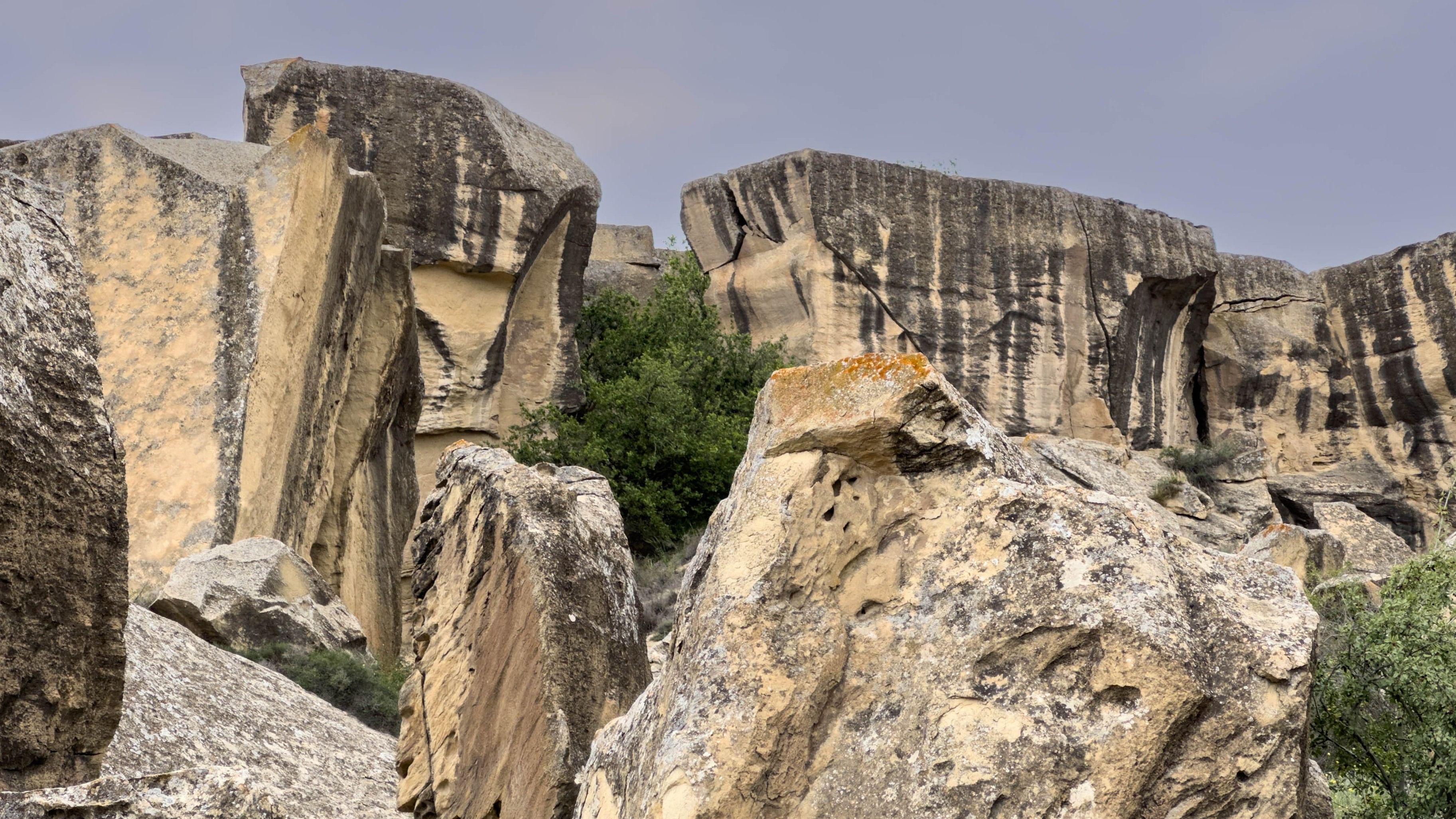
Crumbling rock shelters of Gobustan.
Credit: Photo by Author
The transformation of the landscape from glamorous big-city Baku, with its glitzy architecture and intriguing medieval old town, to the arid stretch of land that constitutes Gobustan State Reserve is dramatic. The drive to the state reserve is worth the hour and fifteen minutes it takes to get there, for the place is a UNESCO World Heritage Site and a five-star cultural haven. The obvious highlights are the ancient rock carvings or petroglyphs, more than 6,000 in number. These images, drawn or engraved into the cave-like shelters here, date between the Mesolithic and early Neolithic periods and reflect 40,000 years of rock art.
Before approaching the actual site, with its stone and bronze age carvings, we stop at the state-of-the-art Gobustan Museum. Ethnographically revealing, the museum brims over with multimedia exhibits that contextualise the archaeological findings. It becomes apparent that the archaeological discoveries made here, indicate that Azerbaijan was one of the ancient centres of civilisation. Early man depicted on rock, the intense activity that constituted his life — caring for livestock, hunts, shamanism, dance rituals and burial rites. It is here I learn that the Norwegian explorer, Thor Heyerdahl, who repeatedly visited Azerbaijan and spent time studying the petroglyphs, pointed out a similarity between the ships depicted on rocks here and those used by the Vikings. He concluded that the Vikings migrated to Norway from Azerbaijan.
The first expeditions to Gobustan in the 1940s, under the leadership of I M Jafarzade, were to find, describe and make drawings of these petroglyphs. In Gobustan, the periodisation of petroglyphs was challenging, because people have lived here for many thousands of years, and artists of different eras have used the same rocks to express their creativity. For example, other images have been added atop the petroglyph of the big aurochs.
After a worthy two hours spent in the museum, we drive five minutes to the site that must have once been inhabited caves, and a human settlement with burial sites. Today it is a craggy mass of larger-than-life boulders and crumbling rock shelters, created as an outcome of earthquakes. As we approach, we encounter a triangle-shaped rock called Gaval Dash. My guide Pervin taps out a rhythmic tune on the rock face, that produces a sound like a tambourine when struck. Pervin tells me that the folks who once lived here probably used these rocks for their rituals.
Panels outside the caves, upon easily walkable pathways, offer basic information on the petroglyphs that we see. For instance, the depiction of people with joined hands standing in a line has been interpreted as dancing before a hunt to secure its success. Today a similar dance formation indicating cultural continuity, can be seen in the Azerbaijani folk dance called Yalli. Explorers were also mystified at first by what looked like dolphins depicted in the caves. Some archaeologists, however, understood that these were none other than the Ichthyosaur, a dinosaur that went extinct around ninety million years ago, and that looks similar to the modern dolphin.
For prehistoric people, interactions with animals involved spiritual and social aspects. For example, ancient inhabitants of Gobustan hunted bezoar goats but also venerated them in their petroglyphs. In many prehistoric cultures, people have been found to adorn their bodies. Petroglyphs indicate that the inhabitants of Gobustan were no exception. Those who inhabited these caves used bones, shells, and later metals to craft their jewellery. Charms and amulets were both ornamental, as well as invested with symbolic meaning.
Boats are also featured commonly in rock art. Here too, both a literal and symbolic meaning accompanied their presence. They indicate the technological achievement of people, as knowledge of boat-making was important since fishing was key to the survival of the inhabitants. Boats also feature in ancient myth as a vehicle to carry people to the next world.
If you’ve made it as far as the petroglyphs, drive 10 km further south to a cluster of equally fascinating mud volcanoes. Around 300 of the 700 mud volcanoes that exist in the world are found in Azerbaijan, of which several are located in Gobustan. Mud volcanoes occur when tectonic movement, pressurises subterranean gases, silt, and clay to escape to the earth’s surface. Located just a few feet from each other, these geologically flatulent mounds belch cold thick grey mud, rather than boiling lava. This otherworldly landscape, spartan except for the mounds, has had NASA geologists studying the planet Mars, drawing comparisons between the volcanoes and certain areas on Mars. Rich oil and gas deposits have been found in the area surrounding the volcanoes.
Besides the obvious novelty of the site, the mounds are appreciated for their muddy benefits. The materials from their eruptions — lava and mud, are used as raw materials for the chemical industry and for pharmacological cures. In certain demarcated zones, people are permitted to wallow in the mud. The clay is deemed beneficial for an array of diseases from rheumatism to disorders of the skin and nervous system. The opportunity to ponder the wonders of nature and culture in this most unusual setting is as healing for the soul as it is unique.